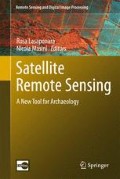Abstract
It’s a fact that today archaeologists can interact ever more closely with the modern sciences of surveying, which as a whole may fall under the name of Geomatics. A scientific approach to Archaeology may be in fact reflected in the first place in the adoption of methods, both objective and based on rigorous criteria and tools, for knowing and describing the goods. Remote Sensing, as a technique for surveying a site from a distance by means of special detectors and using management methods based on mathematical and physical models, is by nature a practical expression of this phenomenon, whether it is meant in the most common meaning of use of satellite data or extending its acceptation to aerial photogrammetry. The paper will review some of the issues related to the use of Remote Sensing in the archaeological context, but particularly in relation to other disciplines of Geomatics; Remote Sensing is not, as noted, a technique that is “self contained” and restricted in its scientific and technical areas independently, but it relies on the wealth of other techniques and scientific fields, and they must fit perfectly, especially for applications in Archaeology which have by nature a highly multidisciplinary vocation.
Access this chapter
Tax calculation will be finalised at checkout
Purchases are for personal use only
References
Abrams M, Hook S, Ramachandran B (2002) ASTER users handbook, version 2. EROS Data Center, Sioux Falls
Beck A, Philip G, Abdulkarim M, Donoghue D (2007) Evaluation of Corona and Ikonos high resolution satellite imagery for archaeological prospection in western Syria. Antiquity 81:161–175
Bitelli G, Girelli VA (2009) Metrical use of declassified satellite imagery for an area of archaeological interest in Turkey. J Cult Herit 10S:35–40
Bitelli G, Zanni M (2005) Use of Ikonos high resolution imagery in archaeology: the example of the ancient city of Bakchias in Egypt. In: Oluic M (ed) New strategies for European Remote Sensing. Millpress, Rotterdam, pp 23–30
Bitelli G, Carrara A, Gusella L (2005) Evaluation and use of DEMs derived from ASTER imagery. In: Proceedings workshop Italy – Canada 2005 “3D digital imaging and modeling: applications of heritage industry medicine and land”, CD-Rom, Padova, 8 pp
Buyuksalih G, Jacobsen K (2007) Comparison of DEM generation by very high resolution optical satellites. In: Bochenek Z (ed) New developments and challenges in remote sensing. Millpress, Rotterdam, pp 627–637
Campana S, Forte M (2006) In: Proceedings of the 2nd international conference on remote sensing in archaeology: from space to place, British Archaeological Reports, Rome
Cheng P, Chaapel C (2010) WorldView-2 satellite – Pan-sharpening and geometric correction. GeoInformatics 13(4):30–33
Galiatsatos N, Donoghue DNM, Philip G (2008) High resolution elevation data derived from stereoscopic CORONA imagery with minimal ground control: an approach using Ikonos and SRTM data. Photogramm Eng Rem S 74(9):1093–1106
Gusella L, Adams BJ, Bitelli G, Huyck CK, Mognol A (2005) Object oriented image understanding and post-earthquake damage assessment for the 2003 Bam, Iran, Earthquake. Earthq Spectra 21(S1):225–238
Hirano A, Welch R, Lang H (2003) Mapping from ASTER stereo image data: DEM validation and accuracy assessment. ISPRS J Photogramm 57:356–370
Jacobsen K (2005) Analysis of digital elevation models based on space information. In: Oluic M (ed) New strategies for European Remote Sensing. Millpress, Rotterdam, pp 439–451
Lang HR, Welch R (1999) Algorithm theoretical basis document for ASTER digital elevation models, version 3.0. (http://eospso.gsfc.nasa.gov)
Lasaponara R, Masini N (2006) On the potential of Quickbird data for archaeological prospection. Int J Remote Sens 27(15–16):3607–3614
Lasaponara R, Masini N (2008) Advances on remote sensing for archaeology and cultural heritage management. In: Proceedings of the 1st International EARSeL workshop Aracne, Rome
Menze BH, Sherratt AG (2006) Detection of ancient settlement mounds: archaeological survey based on the SRTM terrain model. Photogramm Eng Rem S 72:321–327
Poli D, Remondino F, Dolci C (2004) Use of satellite imagery for DTM extraction, landscape modeling and GIS applications. In: Proceedings of the international workshop on processing and visualization using high-resolution imagery, Pitsanulok, Thailand
Scollar I, Tabbagh A, Hesse A, Herzog I (2009) Archaeological prospecting and remote sensing. Cambridge University Press, Cambridge
Toutin T (2001) Geometric processing of Ikonos Geo images with DEM. In: ISPRS joint workshop “High resolution mapping from space”, Hanover, Germany
Vittuari L (2008) Precise global georeferencing of sites and geodetic techniques for morphological surveys within a common reference frame. In: ARCHAIA. Guidelines on research planning, characterisation, conservation and management in archaeological sites, British Archaeological Reports International Series, BAR S1877, 59–65, Archaeopress, Oxford
Wiseman J, El-Baz F (2008) Remote sensing in archaeology. Springer, New York
Author information
Authors and Affiliations
Corresponding author
Editor information
Editors and Affiliations
Rights and permissions
Copyright information
© 2012 Springer Science+Business Media B.V.
About this chapter
Cite this chapter
Bitelli, G. (2012). Remote Sensing and Integration with Other Geomatic Techniques in Archaeology. In: Lasaponara, R., Masini, N. (eds) Satellite Remote Sensing. Remote Sensing and Digital Image Processing, vol 16. Springer, Dordrecht. https://doi.org/10.1007/978-90-481-8801-7_5
Download citation
DOI: https://doi.org/10.1007/978-90-481-8801-7_5
Published:
Publisher Name: Springer, Dordrecht
Print ISBN: 978-90-481-8800-0
Online ISBN: 978-90-481-8801-7
eBook Packages: Earth and Environmental ScienceEarth and Environmental Science (R0)

